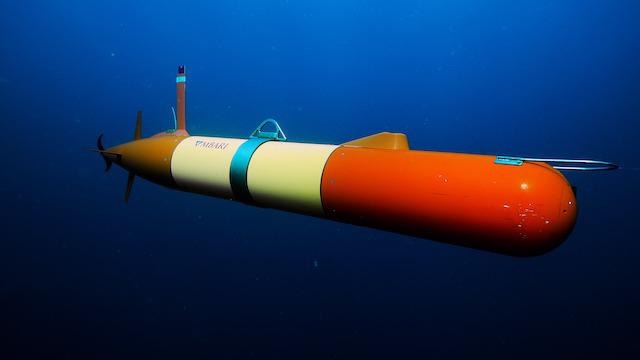In a big step toward better monitoring of the biodiversity of ocean ecosystems, new research recently published in the journal Environmental DNA details how Monterey Bay Aquarium Research Institute (MBARI) scientists are employing unmanned underwater robots to sample environmental DNA (eDNA).
 When outfitted with a groundbreaking “laboratory in a can” to sample environmental DNA (eDNA), nimble robots like MBARI’s long-range autonomous underwater vehicle (LRAUV) can expand monitoring of ocean health. Image Credit: © 2021 MBARI/Monterey Bay Aquarium
When outfitted with a groundbreaking “laboratory in a can” to sample environmental DNA (eDNA), nimble robots like MBARI’s long-range autonomous underwater vehicle (LRAUV) can expand monitoring of ocean health. Image Credit: © 2021 MBARI/Monterey Bay Aquarium
eDNA allows researchers to identify the presence of aquatic species from the minute pieces of genetic material they shed. This DNA cluster provides indications about biodiversity variations in sensitive regions, the presence of uncommon or endangered species, and the increase of invasive species — all important to comprehending, promoting, and preserving a healthy ocean.
For the research, scientists integrated two unique autonomous systems created by MBARI: the Environmental Sample Processor (ESP) and the long-range autonomous underwater vehicle (LRAUV).
The LRAUV is a dexterous robot that can travel to secluded regions of the ocean for a long stretch of time. The ESP is a robotic “laboratory-in-a-can” that sieves seawater and conserves eDNA for future research. By providing an ESP with LRAUV technology, scientists can increase the scale of marine monitoring over space and time.
In contrast, conventional sampling of eDNA in the ocean necessitates weeks on a costly research vessel restricted to a localized region. Innovative technologies like this are transforming marine conservation attempts.
We know that eDNA is an incredibly powerful tool for studying ocean communities, but we’ve been limited by what we can accomplish using crewed research vessels. Now, autonomous technology is helping us make better use of our time and resources to study new parts of the ocean.
Kobun Truelove, Study Lead Author and Biological Oceanographer, MBARI
Ocean biodiversity is a measure of the copious number of species and individuals in the seas. This interlinked variety of organisms — from the smallest plankton to the biggest whales — creates the air we breathe, supports food webs, and controls our climate. Autonomous tools such as the ESP and LRAUV allow MBARI scientists to keep a constant presence in the ocean and track variations in delicate ecosystems in ways that were not feasible in the past.
Organisms move as conditions change in our oceans and Great Lakes, affecting the people and economies that rely on those species. We need cheaper and more nimble approaches to monitor biodiversity on a large scale. This study provides the synergistic development of eDNA and uncrewed technologies we need, in direct response to priorities laid out in the NOAA ‘Omics Strategic Plan.
Kelly Goodwin, study co-author and collaborator, National Oceanic and Atmospheric Administration
For this study, MBARI worked together with scientists at the National Oceanic and Atmospheric Administration’s (NOAA) Atlantic Oceanographic and Meteorological Laboratory and the University of Washington to conclude three expeditions in the Monterey Bay National Marine Sanctuary. The team synchronized sample collection between the three research vessels of MBARI, a fleet of MBARI’s LRAUVs, and the NOAA Fisheries ship Reuben Lasker.
A ship-based team dropped bottles to a particular depth to gather and preserve water samples. In the meantime, an LRAUV fitted with an ESP autonomously sampled and preserved eDNA at analogous depths and locations. The eDNA samples were sent to the lab for detailed sequencing.
Interconnected organisms share typical sections of DNA, called gene markers. For this research, the team examined eDNA samples via a method called metabarcoding. This technique seeks short DNA excerpts and offers a breakdown of the groups observed in the sample.
This method is particularly useful for interpreting eDNA data into a measure of biodiversity. The scientists examined four diverse kinds of gene markers, each signifying a marginally diverse level of the food web. Together, the results produced a more complete picture of community composition. The samples gathered from research vessels and unmanned vehicles demonstrated similar forms of biodiversity.
Truelove observed that the results from the study signify a stimulating step forward for tracking ocean ecosystems.
“This work is all about increasing the scale of eDNA research. Instead of looking at an individual species, we can start to more broadly characterize biological community structure in the ocean,” he stated.
Good data are the bedrock of sustainable ocean management. Regular environmental DNA monitoring tells us who is there and what is changing over time. When it comes to understanding the impacts of climate change—one of the biggest threats to ocean health—this information is essential.
Francisco Chavez, Senior Scientist and Study Co-Author, MBARI
LRAUVs can continuously travel for weeks as well as for hundreds of kilometers. They can facilitate more frequent sampling in regions of interest than conventional research ships, which only visit isolated sites on the odd occasion.
Autonomous robots will enable scientists to explore formerly unsurveyed areas of the deep sea. Filling in these holes in the data is important to establishing ocean health worldwide. Ship-based exploration will continue to have an important role to play in oceanographic studies, but incorporating a new autonomous platform into the toolkit will increase the capacity for research, tracking, and management of resources.
In due course, MBARI scientists foresee positioning a fleet of LRAUVs fitted with ESP technology.
The study received support from the David and Lucile Packard Foundation, NOAA/OAR/NOPP, NOAA/OAR/’Omics, and NASA Projects #80NSSC20M0001 and 80NSSX21M003.
Environmental DNA: How to see the genetic clues left behind in a drop of water
Environmental DNA (eDNA) helps researchers identify marine animals by the DNA “fingerprint” they leave behind. Video Credit: © 2022 MBARI
Journal Reference:
Truelove, N. K., et al. (2022) Expanding the temporal and spatial scales of environmental DNA research with autonomous sampling. Environmental DNA. doi.org/10.1002/edn3.299.